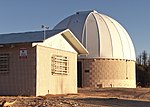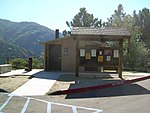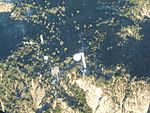Silver Moccasin Trail
Angeles National ForestArcadia, CaliforniaNational Recreation Trails in CaliforniaProtected areas of Los Angeles County, CaliforniaSan Gabriel Mountains ... and 3 more
San Gabriel Mountains National MonumentScouting monuments and memorialsWrightwood, California

The Silver Moccasin Trail is a 53-mile (85 km) trail located in the San Gabriel Mountains, northeast of Los Angeles. It begins at Chantry Flat Recreation Area above the city of Arcadia, California, traversing upward and down through several canyons and along the high ridges of the Angeles National Forest. This trail connects Mt. Baden-Powell, Mount Burnham, Throop Peak and Mount Hawkins. It comes to its highest point of 9,399 feet (2,865 m) at Mount Baden-Powell after which point it descends to its terminus at Vincent Gap on the Angeles Crest Highway near Wrightwood.
Excerpt from the Wikipedia article Silver Moccasin Trail (License: CC BY-SA 3.0, Authors, Images).Silver Moccasin Trail
Angeles Crest Highway,
Geographical coordinates (GPS) Address Nearby Places Show on map
Geographical coordinates (GPS)
| Latitude | Longitude |
|---|---|
| N 34.306388888889 ° | E -118.01027777778 ° |
Address
Angeles Crest Highway
Angeles Crest Highway
93553
California, United States
Open on Google Maps









